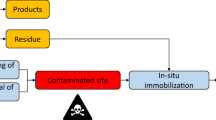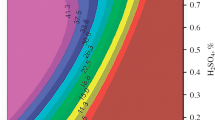Abstract
Mechano-chemical treatment has been recognized to be a promising technology for the immobilization of heavy metals (HMs) in contaminated soils without the use of additional reagents. Despite this, very few studies aiming to investigate the applicability of this technology at full scale have been published so far. In this study, a quantitative approach was developed to provide process design information to scale-up from laboratory- into pilot-scale mechano-chemical reactors for immobilizing heavy metals in contaminated mining soil. In fact, after preliminary experiments with laboratory-scale ball mills, experiments have been carried out by taking advantage of milling devices suited for pilot-scale applications. The experimental data of this work, along with literature ones, have been quantitatively interpreted by means of a mathematical model allowing to describe the effect of milling dynamics on the HM immobilization kinetics for applications at different scales. The results suggest that the mechanical process can trigger specific physico-chemical phenomena leading to a significant reduction of HMs leached from mining soils. Specifically, after suitably prolonged processing time, HM concentration in the leachate is lowered below the corresponding threshold limits. The observed behavior is well captured by the proposed model for different HMs and operating conditions. Therefore, the model might be exploited to infer design parameters for the implementation of this technique at the pilot and full scale. Moreover, it represents a valuable tool for designing and controlling mechano-chemical reactors at productive scale.









Similar content being viewed by others
Abbreviations
- C R :
-
Charge ratio (–)
- f :
-
Collision frequency (h−1)
- J min :
-
Minimal number of effective collisions (–)
- k :
-
Kinetic constant (h−1)
- k ′ :
-
Kinetic constant (h−1)
- K :
-
Probability of collision (–)
- n :
-
Number of collisions (–)
- m ∗ :
-
Mass involved in physico-chemical transformations (g)
- m :
-
Total mass available within the milling device (g)
- P j :
-
Probability of occurrence an effective hits after j collisions (–)
- q :
-
Total mass fraction of the generic heavy metal (g g−1)
- V l :
-
Volume of the liquid within the mill (L)
- V S :
-
Volume of the solid within the mill (L)
- α :
-
Constant (–)
- ε :
-
Relative error (–)
- ξ :
-
Mass fraction of the generic metal (g g−1)
- ρ S :
-
Density of the solid (g L−1)
- τ :
-
Generic mechanical processing time (h)
- ψ :
-
Mass fraction of the immobilized metal (g g−1)
- HM :
-
Heavy metal
- 0 :
-
Initial condition
- f :
-
Final concentration after leaching
- j :
-
Number of effective collisions
- l :
-
Liquid
- S :
-
Solid
References
Bolan N, Kunhikrishnan A, Thangarajan R, Kumpiene J, Park J, Makino T, Kirkham MB, Scheckel K (2014) Remediation of heavy metal(loid)s contaminated soils—to mobilize or to immobilize? J Hazard Mater 266:141–166. https://doi.org/10.1016/J.JHAZMAT.2013.12.018
Boschetto A, Bellusci M, La Barbera A et al (2013) Kinematic observations and energy modeling of a Zoz Simoloyer high-energy ball milling device. Int J Adv Manuf Technol 69:2423–2435
Cagnetta G, Huang J, Wang B, Deng S, Yu G (2016) A comprehensive kinetic model for mechanochemical destruction of persistent organic pollutants. Chem Eng J 291:30–38. https://doi.org/10.1016/J.CEJ.2016.01.079
Cagnetta G, Huang J, Yu G (2018) A mini-review on mechanochemical treatment of contaminated soil: from laboratory to large-scale. Crit Rev Environ Sci Technol 1–49
Caschili S, Delogu F, Concas A et al (2006) Mechanically induced self-propagating reactions: analysis of reactive substrates and degradation of aromatic sulfonic pollutants. Chemosphere 63:987–995. https://doi.org/10.1016/j.chemosphere.2005.08.052
Chen Z, Lu S, Mao Q, Buekens A, Chang W, Wang X, Yan J (2016) Suppressing heavy metal leaching through ball milling of fly ash. Energies 9:524
Chen Z, Lu S, Mao Q, Buekens A, Wang Y, Yan J (2017) Energy transfer and kinetics in mechanochemistry. Environ Sci Pollut Res 24:24562–24571
Chen Z, Lu S, Tang M, Lin X, Qiu Q, He H, Yan J (2019) Mechanochemical stabilization of heavy metals in fly ash with additives. Sci Total Environ 694:133813. https://doi.org/10.1016/J.SCITOTENV.2019.133813
Concas A, Montinaro S, Pisu M, Cao G (2007) Mechanochemical remediation of heavy metals contaminated soils: modelling and experiments. Chem Eng Sci 62:5186–5192. https://doi.org/10.1016/j.ces.2007.02.024
Concas A, Pisu M, Cao G (2019) Mechanochemical immobilization of heavy metals in contaminated soils: a novel mathematical modeling of experimental outcomes. J Hazard Mater 388:121731. https://doi.org/10.1016/J.JHAZMAT.2019.121731
Çoruh S, Elevli S, Ergun ON, Demir G (2013) Assessment of leaching characteristics of heavy metals from industrial leach waste. Int J Miner Process 123:165–171. https://doi.org/10.1016/J.MINPRO.2013.06.005
Delogu F, Takacs L (2014) Mechanochemistry of Ti–C powder mixtures. Acta Mater 80:435–444. https://doi.org/10.1016/J.ACTAMAT.2014.08.036
Delogu F, Deidda C, Mulas G, Schiffini L, Cocco G (2004) A quantitative approach to mechanochemical processes. J Mater Sci 39:5121–5124
Garroni S, Takacs L, Leng H, Delogu F (2014) Kinetics of the mechanochemical synthesis of alkaline-earth metal amides. Chem Phys Lett 608:80–83. https://doi.org/10.1016/J.CPLETT.2014.05.071
I.L.D (2006) Italian Legislative Decree no. 152, 2006. Norme in materia ambientale. Suppl Ordin no 96, Gazz Uff No 88
Lee C-H, Truc NTT, Lee B-K, Mitoma Y, Mallampati SR (2015) Evaluation of heavy metals in hazardous automobile shredder residue thermal residue and immobilization with novel nano-size calcium dispersed reagent. J Hazard Mater 296:239–247. https://doi.org/10.1016/J.JHAZMAT.2015.04.039
Lu M, Lv T, Li Y, Peng Z, Cagnetta G, Sheng S, Huang J, Yu G, Weber R (2017) Formation of brominated and chlorinated dioxins and its prevention during a pilot test of mechanochemical treatment of PCB and PBDE contaminated soil. Environ Sci Pollut Res 24:20072–20081
Mallampati SR, Mitoma Y, Okuda T, Sakita S, Kakeda M (2012a) Enhanced heavy metal immobilization in soil by grinding with addition of nanometallic Ca/CaO dispersion mixture. Chemosphere 89:717–723. https://doi.org/10.1016/J.CHEMOSPHERE.2012.06.030
Mallampati SR, Mitoma Y, Okuda T, Sakita S, Kakeda M (2012b) High immobilization of soil cesium using ball milling with nano-metallic Ca/CaO/NaH2PO4: implications for the remediation of radioactive soils. Environ Chem Lett 10:201–207
Mallampati SR, Mitoma Y, Okuda T, Sakita S, Kakeda M (2012c) Enhanced heavy metal immobilization in soil by grinding with addition of nanometallic Ca/CaO dispersion mixture. Chemosphere 89:717–723. https://doi.org/10.1016/J.CHEMOSPHERE.2012.06.030
Mallampati SR, Mitoma Y, Okuda T, et al (2013) Solidification and immobilization of heavy metals in soil using with nano-metallic Ca/CaO dispersion mixture. In: E3S Web of Conferences. p 35002
Manca G, Cervone G (2013) The case of arsenic contamination in the Sardinian Geopark, Italy, analyzed using symbolic machine learning. Environmetrics 24:400–406
Montinaro S, Concas A, Pisu M et al (2007a) Immobilization of heavy metals in contaminated soils. Chem Eng Trans 11:797–802
Montinaro S, Concas A, Pisu M, Cao G (2007b) Remediation of heavy metals contaminated soils by ball milling. Chemosphere 67:631–639. https://doi.org/10.1016/j.chemosphere.2006.11.009
Montinaro S, Concas A, Pisu M, Cao G (2007c) Remediation of heavy metals contaminated soils by ball milling. Chemosphere 67:631–639. https://doi.org/10.1016/j.chemosphere.2006.11.009
Montinaro S, Concas A, Pisu M, Cao G (2008) Immobilization of heavy metals in contaminated soils through ball milling with and without additives. Chem Eng J 142:271–284. https://doi.org/10.1016/j.cej.2007.12.003
Montinaro S, Concas A, Pisu M, Cao G (2009) Rationale of lead immobilization by ball milling in synthetic soils and remediation of heavy metals contaminated tailings. Chem Eng J 155:123–131. https://doi.org/10.1016/j.cej.2009.07.005
Montinaro S, Concas A, Pisu M, Cao G (2012) Rationale of heavy metals immobilization by ball milling in synthetic soils and remediation of heavy metals contaminated tailings. In: Chemical Engineering Transactions. pp 263–268
Nenadović SS, Kljajević LM, Nenadović MT, Mirković MM, B. Marković S, Rakočević ZL (2015) Mechanochemical treatment and structural properties of lead adsorption on kaolinite (Rudovci, Serbia). Environ earth Sci 73:7669–7677
Sannia M, Orru R, Concas A et al (2001) Self-propagating reactions for environmental protection: remarks on the treatment and recycling of zinc hydrometallurgical wastes. Ind Eng Chem Res 40:801–807. https://doi.org/10.1021/ie000476r
Shin Y-J, Park S-M, Yoo J-C, Jeon CS, Lee SW, Baek K (2016) A new approach for remediation of As-contaminated soil: ball mill-based technique. Environ Sci Pollut Res 23:3963–3970
Sui H, Li H, Song J et al (2015) Selection of milling reagents for mechanochemical degradation of high concentrations of DDTs in contaminated soil. Res Environ Sci 28:1227–1233
Vareda JP, Valente AJM, Durães L (2019) Assessment of heavy metal pollution from anthropogenic activities and remediation strategies: a review. J Environ Manage 246:101–118. https://doi.org/10.1016/J.JENVMAN.2019.05.126
Yuan W, Xu W, Zhang Z, Wang X, Zhang Q, Bai J, Wang J (2019a) Rapid Cr(VI) reduction and immobilization in contaminated soil by mechanochemical treatment with calcium polysulfide. Chemosphere 227:657–661. https://doi.org/10.1016/J.CHEMOSPHERE.2019.04.108
Yuan W, Xu W, Zheng J, Wang XY, Zhang QW (2019b) Immobilization of Pb, Cu and Zn in contaminated soil using ball milling technique. J Contam Hydrol 225:103514. https://doi.org/10.1016/J.JCONHYD.2019.103514
Zhiliang C, Minghui T, Shengyong L, Buekens A, Jiamin D, Qili Q, Jianhua Y (2019) Mechanochemical degradation of PCDD/Fs in fly ash within different milling systems. Chemosphere 223:188–195. https://doi.org/10.1016/j.chemosphere.2019.02.066
Author information
Authors and Affiliations
Corresponding author
Ethics declarations
Conflict of interest
The authors declare that they have no competing interests.
Additional information
Responsible editor: Kitae Baek
Publisher’s note
Springer Nature remains neutral with regard to jurisdictional claims in published maps and institutional affiliations.
Electronic supplementary material
ESM 1
(DOCX 3756 kb)
Rights and permissions
About this article
Cite this article
Concas, A., Montinaro, S., Pisu, M. et al. Experiments and modeling of mine soil inertization through mechano-chemical processing: from bench to pilot scale using attritor and impact mills. Environ Sci Pollut Res 27, 31394–31407 (2020). https://doi.org/10.1007/s11356-020-09445-1
Received:
Accepted:
Published:
Issue Date:
DOI: https://doi.org/10.1007/s11356-020-09445-1




